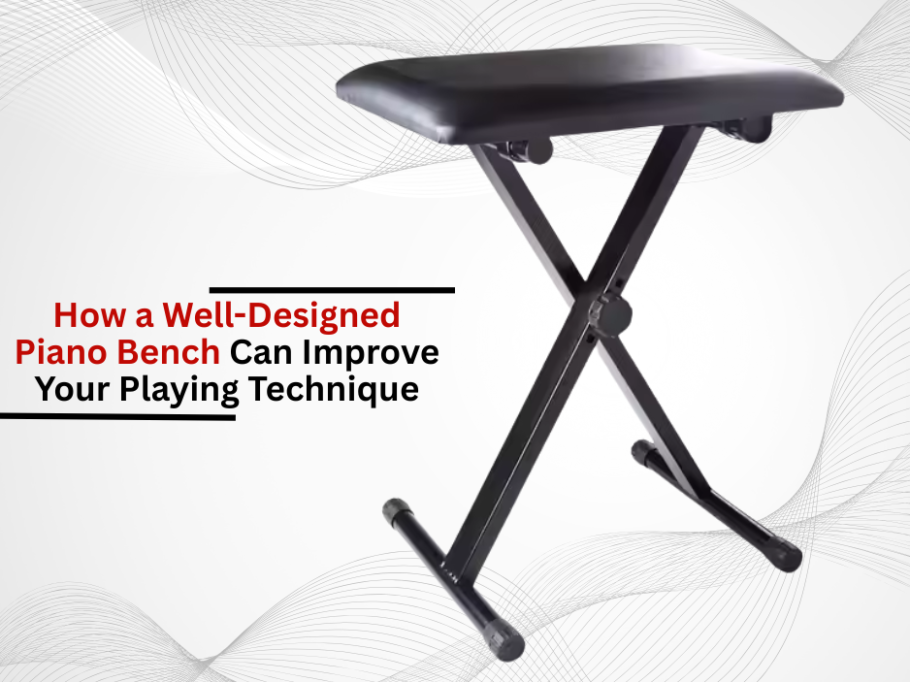An ergonomic piano bench helps to optimize the playing techniques of an individual by refining biomechanics and ergonomics. Undoubtedly, posture plays a crucial role in determining the technique effectiveness and proficiency of a pianist. Therefore, a properly designed ergonomic bench functions as much more than just a seat. In fact, it influences control, endurance, and alignment. The combination of these factors could reshape playing techniques while also reducing fatigue and enhancing quality. The only remaining question is how the bench design interplays with the suggested improvements.
To know more, read: The Importance of Proper Seating Posture for Pianists
Ergonomics and Adjustment Views
Body Mechanics Alignment:
Shoulders and wrists relax best when the forearms rest parallel to the floor. Into the range of modern playing, it becomes clearer that relying on rigid standardizations also arises. Leading to decreased versatility in performing movements of the arms above and forward, the body midsection accomplishes effortless mechanical movements guiding fingers to be set into place. Adjustable features also foster novel hand positions at ease. Benches designed and retuned with wrought zinc, lead, and copper or bronze alloys permit eczema ablution tuning to individual anthropometrics.
Tilt Control and Weight Adjustment:
Excess pressure on specific leg sections impedes pedal technique, particularly in excessive patter serving rapid passage, where multiple notes have to be played simultaneously. Split seat designs permit weight contouring to improve thigh and hip’ weight distribution. Dynamic contouring placed pads strategically positioned enhance pedal work stability while using Roland’s ergonomic series.
Dynamic Modifications For Accurate Work
Height Changes and Technical Variations:
Pianos with fixed-height benches restrict a pianist’s skill set to a singular style or genre. For example, Baroque pieces may skillfully capture nimble ornamentation but would require a lower seat. On the other hand, the Romantic era works greatly benefit from a high seating position due to the application of arm weight. Benches that can be fixed in height help in genre optimization to maximize fluidity on technique crossovers.
Tilt Adjustment and Finger Movement:
The forward tilt mechanism assists in subtly shifting the pelvis, nudging the user towards the keyboard. This has the effect of enhancing finger independence and power in forte passages. While this is standard in professional-level benches, gentle tilt can also be achieved by strategically placing cushions.
Material Impact on Stability
Vibration Dampening and Touch Sensitivity:
Aggressive playing for advanced pieces may cause unintended alterations in posture due to unsecured seating. This is readily solved in advanced seating with dense foam rubbers, as the skirts absorb vibration without them shifting posture. Consistent touch sensitivity is ensured by stable seating since micro-movements caused by wobbling, which are crucial in rapid octave jumps or trills performed using advanced techniques, are eliminated.
Surface Friction and Movement Restriction:
The friction caused by upholstery impacts the amount of sliding a pianist can perform while playing. For instance, with smooth leather, minimal repositioning is possible and will use rubato expressively, while grippy fabrics with little slip will ensure staccato can be performed precisely. They may select whichever they prefer or what helps style the work best.
Psychological and Physiological Benefits
Focus Retention and Effort Decrease:
Discomfort acts as a subconscious red herring. Because of this, it distracts and fragments users’ focus. Supportive armrests and deep lumbar seating help with strain, which in turn enhances productivity. Improved comfort helps improve stamina, especially when the user is engaging with difficult passages.
Posture-Related Injuries:
Less severe tension-related injuries and consistent technical precision can come from changes in a user’s posture. A firm surface under the bench helps unlock core muscles to preserve manually active postures over long periods.
Design Considerations for Specific Genres
Contemporary vs. Classical Needs:
While jazz or pop performers might prefer the cushiony ease of improvisational movement, classical performers prefer controlled phrasing bound with rigid support. Modular components in model design hybrids such as On Stage are ideal for both sides of the pendulum.
Educational Bench Features:
For these students, teachers often need to consider the different shapes each student using the bottom will take. Greater alignment and interchangeable pads make for faster skill development.
Need this in bulk? You can get this from wholesale – piano bench
If you need this at the best prices, you might check out this new platform – piano bench
Conclusion
An ergonomically designed piano bench complements the instrument and helps to refine technique as it encourages proper form and adaptive movements. Brands like 5 Core, Roland, and Donner demonstrate this fusion by providing anatomical and artistic responsive solutions. Benches with great design will help advanced musicians shape their skills while freeing orchestrating students from obstacles that delay their progress.






